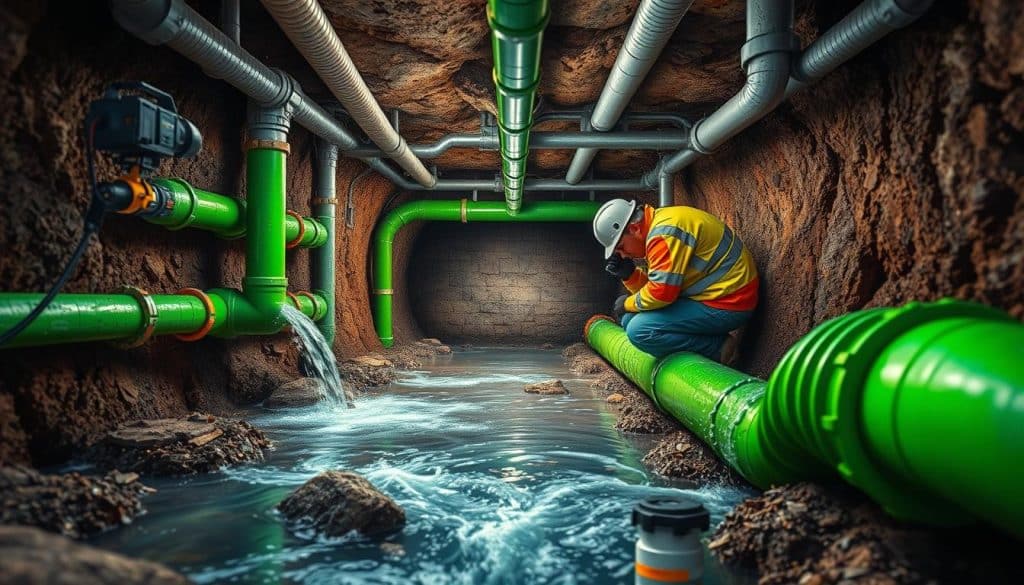Ever thought about How Often Should a Sewer Line Be Inspected? Keeping it in good shape can save you from big headaches. It’s all about avoiding unexpected problems.
Getting your sewer line checked is key for any homeowner. It helps keep your plumbing working well. Experts say you should check it every three to five years. But, if you notice something’s off, get it looked at right away.
With the right care, your sewer line could last for decades. This shows how important regular checks are. For Chicago, IL residents, J Sewer & Drain Plumbing Inc. has your back with reliable services.
Key Takeaways
- Regular sewer line maintenance can prevent costly problems.
- An inspection schedule every three to five years is generally recommended.
- Immediate inspections are essential if issues are suspected.
- Sewer lines well-maintained can last up to 100 years.
- J Sewer & Drain Plumbing Inc. offers reliable guarantees, especially for those in the Chicago area.
Benefits of Regular Sewer Line Inspections
The importance of sewer line inspections is huge. They help prevent emergencies and find pipe corrosion early. Modern video technology lets us see inside the sewer lines without digging. This way, we can spot blockages and check the pipe’s condition.

Doing routine sewer line checks helps catch problems before they get big. This saves homeowners from expensive repairs. Regular inspections keep the sewer system working well and last longer.
Experts say regular checks are key. The top sewer line inspection recommendations suggest doing them every year or two. These inspections make your sewer system work better and last longer. It’s a smart way to protect your home and health.
Signs That Indicate a Sewer Line Inspection Is Needed
Knowing when to get a sewer line inspection is key for homeowners. Spotting early signs can prevent big damage and expensive fixes. Here are important symptoms to look out for and tips for sewer line inspections.
Foul Odors
Foul smells from sinks, drains, or outside near your sewer line are a warning sign. They often mean blockages or leaks. A pro can find and fix the problem quickly.
Slow Drainage
Slow drains in sinks, tubs, or showers are another sign. It usually means a big problem in your sewer system. Getting expert advice can help fix it before it gets worse.

Clogged Toilets
Constant toilet clogs that won’t go away might mean a big issue. It could be tree roots or something else blocking your sewer line. Getting an inspection can stop bigger plumbing problems.
Gurgling Noises
Gurgling sounds from drains or toilets mean trapped air. It’s a sign of a blockage or leak. It’s time to check your sewer lines to fix the problem before it gets worse.
These signs mean you should call J Sewer & Drain Plumbing Inc. fast. They can catch problems early and save you from costly repairs in Chicago.
Best Practices for Sewer Line Inspection Frequency
Regular sewer line inspections are key to avoiding expensive repairs. J Sewer & Drain Plumbing Inc. suggests checking your sewer lines every one to two years. This helps catch problems early and fix them before they get worse.
Older pipes are more prone to damage and need extra attention. If you’re moving into a new home, get a detailed inspection of the sewage system. Following these best practices keeps your pipes in good shape and improves your sewage system’s performance.
For a sewer system that works well, include sewer camera inspections in your maintenance routine. These inspections show the inside of the pipes, helping find small cracks, clogs, or other issues. Regular inspections prevent small problems from turning into big ones, saving you money in the long run.
How Often Should a Sewer Line Be Inspected?
Knowing when to check your sewer line is key to keeping it working well. This part will talk about how often new homeowners should check theirs. It will also cover what makes you need a check-up and signs that mean you should get one.
Recommendations for New Homeowners
New homeowners in Chicago, IL, should get their sewer lines checked right away. Companies like J Sewer & Drain Plumbing Inc. offer deals to help. Getting your sewer line checked early can save you a lot of money and trouble later.
Factors Affecting Inspection Frequency
How often you need to check your sewer line depends on a few things. The age and material of the line, and its maintenance history are important. Older or less common materials might need checks more often to avoid problems.
Signs of Potential Sewer Line Issues
Spotting early signs of trouble is crucial for sewer line care. Watch for things like water levels in toilets that don’t seem right, debris in drains, and slow draining. These signs usually mean there’s a bigger issue that needs fixing fast.
Methods Used in Sewer Line Inspections
Knowing how sewer line inspections work is key for homeowners. Thanks to new tech, these inspections are now more precise and less invasive. This change makes checking your sewer line much easier.
Video Sewer Inspections
Video sewer inspections are a big leap forward. They use a small, high-def camera to explore the sewer line. Companies like J Sewer & Drain Plumbing Inc. use this tech to show what’s inside the sewer system live.
This method helps find problems like blockages or cracks without digging up your yard. It’s a big improvement over old ways.
Traditional Methods vs. Modern Technology
Old methods were slow and often wrong. They needed digging and guessing. But now, new tech like video cameras makes inspections fast and accurate.
This change saves time and money. As tech gets better, sewer line checks will keep getting easier and more reliable. It’s now the top choice for homeowners.


